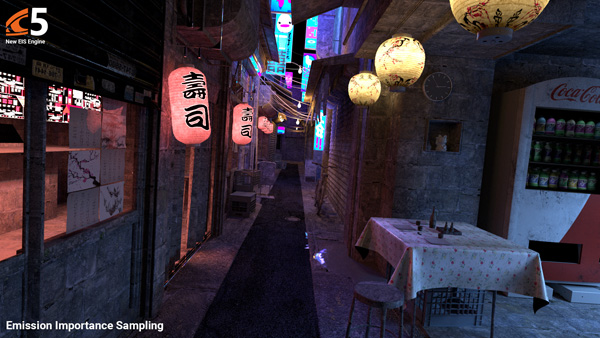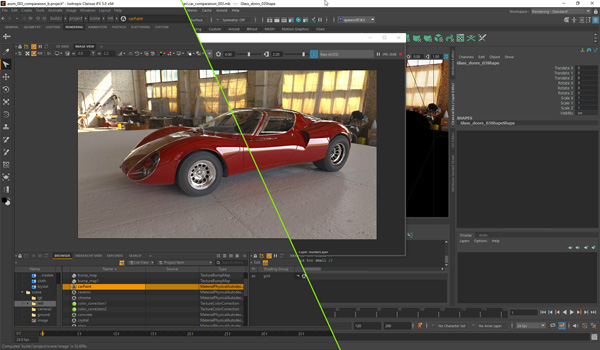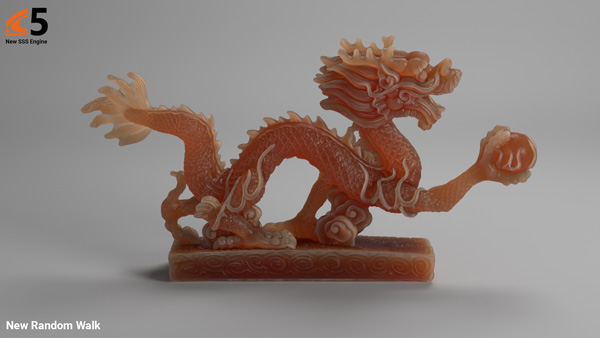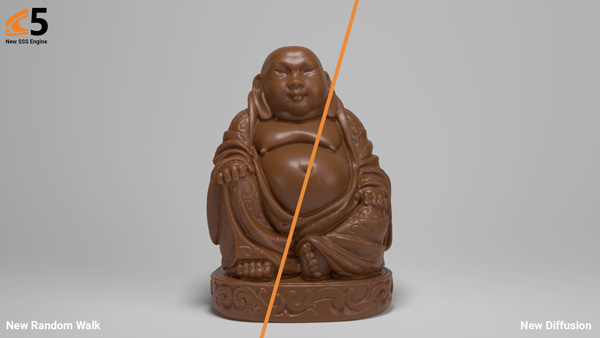
Emission Importance Sampling in Clarisse 5 - all lighting in this render comes from the emissive property of the materials.
Isotropix Clarisse 5 contains updates that address set dressing, look development, lighting, rendering and workflow. The application now has a multi-purpose PBR material based on the Autodesk Standard Surface Material specification. A new unbiased rendering feature, Emission Importance Sampling, has been added that can save lighting artists a huge amount of time. Also, upgrades to the Clarisse workflow help make it faster and simpler to use – item attributes are organised into hierarchical groups exposing only the most relevant attributes.
Dedicated Set Dressing
The Isotropix development team has introduced a built-in USD exporter in Clarisse 5 allowing entire Clarisse scenes to be imported into all applications that support USD without using specialised tools. This feature means users can now use Clarisse’s set dressing abilities for layout, and then export the scene as a .usd file to complete lookdev and render in a preferred application.
Expecting an increase in users who mainly carry out layout work in Clarisse 5, the team developed related improvements such as orthographic views and camera overlays to display safe frames and composition guides. An entirely new graph editor comes with all tools necessary to layout and animate scenes, and a dedicated workflow that rapidly switches and manages multiple viewpoints in the scene.

Autodesk Standard Surface Material - Clarisse (left) and Maya/Arnold renders.
Look Development Revisited
Clarisse 5 now has a multi-purpose PBR (physically based rendering) material based on the Autodesk Standard Surface Material (ASSM) specification, a general surface shader that has existing support from Autodesk Arnold and Substance Painter. This development is consistent with Isotropix’s intention to move toward lookdev interoperability – that is, ‘lookdev anywhere and render everywhere’, which is the description of Sebastien Guichou, CTO and co-founder of Isotropix. Sebastien has demonstrated that rendering the same image in Autodesk Arnold and in Clarisse 5 produces results that are indistinguishable from one other.
The new version 5 has a revised subsurface scattering engine built with a more accurate random walk and a faster, better diffusion-based model. Therefore, users can switch between these two methods without first adjusting their materials in order to manage the rendering speed and accuracy tradeoff.
Transmissive materials have also been improved in Clarisse 5 with more controls for shadowing and surface thickness management. Transmission scattering simulation can now render dense transmissive materials very accurately, such as thick and viscous liquids.
Lighting Controls
Significant updates to lighting in Clarisse 5 bring new controls to independently tweak light contributions in diffuse, reflection, refraction or volume paths. Sampling of area lights, especially IES lights in volumes, are improved to produce less noise in renders than Clarisse 4 for the same number of samples.

Random Walk SSS in Clarisse 5
A new mode for lights contributes exclusively to AOVs. When in this mode, lights stop affecting beauty and the contribution is retrieved using light path expressions in AOVs. This feature makes it much simpler to set up rendering of additional fill lights used exclusively for compositing.
The ability to turn arbitrary geometries into lights and render them efficiently is another critical update. Due to the geometry-instancing capabilities in Clarisse, the renderer can now render virtually billions of textured lights while maintaining very fast render times, low memory footprint and a high level of interactivity.
Render Eficiency Upgrades
Emission Importance Sampling (EIS) is a new unbiased rendering feature that updates the sampling of materials that define emission. It can save lighting artists a huge amount of time because it is no longer necessary to mock up emission using manually placed lights. In effect, this change brings together the look development and lighting stages.
The development team has documented several general rendering performance improvements in Clarisse 5. General ray tracing performance is up to 1.5x faster on actual scenes. Fur and hair now use a new engine that always renders curves adaptively and speeds up render times by up to 4 times, especially on challenging scenarios such as long tangled hair.

Random Walk vs Diffusion in Clarisse 5. Results are very close in these renders, allowing artists to switch between the two modes to manage quality and speed tradeoff without adjusting material settings.
Optimisations to volume accelerate render times by over 3 times with multiple scattering enabled, and a new anti-aliasing importance sampling function improves render times by producing better results simultaneously when denoised. A new BxDF path splitting strategy speeds up specular reflection/transmission paths, and a more predictable adaptive anti-aliasing method has been developed based on standard deviation.
Faster, Simpler Workflow
Upgrades to the Clarisse workflow in version 5 help to make the application faster and simpler to use. All item attributes have been reorganised into logical hierarchical groups, for example, and only the most relevant attributes are now exposed by default. From there, users can manage the visibility of attribute groups in the Attribute Editor, which also displays visual hints to identify user-modified attributes.
Global variables can now be promoted and edited more quickly from the main user interface of the application. When linked to expressions, they can be used to create smart project templates that users operate with a simple set of controls. Users also can control the Clarisse evaluation engine, which tracks images for user modification, to prevent it from loading and processing any actual data.

Transmission Scattering Simulation in Clarisse 5
The render history has been improved with a new mode to manage render snapshots. Built-in light path expressions complementing existing AOVs have been added, and light path expressions have been improved to support Clarisse’s material lobes component, so that users can readily extract coating from diffuse or specular layers into individual AOVs to better adjust them in compositing.
VFX Reference Platform
Clarisse 5 is compliant with VFX Reference Platform Calendar Year 2020. All third party libraries shipped with the software now match the versions listed here, including the move to Python 3.7, which is the new default scripting engine in Clarisse 5. As this represents a maor change, it is still possible to run Clarisse 5 using the old Python 2.7 engine, and Isotropix will continue its support during the entire release cycle of Clarisse 5.
Clarisse 5 is available immediately. With the release of Clarisse 5, Isotropix is introducing and entirely new pricing schedule and special offers. More information is available here. www.isotropix.com


